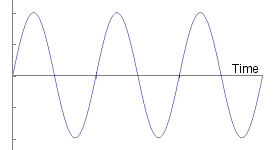AC and DC: Difference between revisions
No edit summary |
|||
| Line 19: | Line 19: | ||
The main advantage of AC is that it can be very easily converted from a high to a low voltage, or vice versa, using a [[Basic_electronic_components#Transformers|transformer]]. Transformers don't work on DC. A high voltage (or electrical pressure) is very good for pushing electricity over large distances, over which the resistance to the flow would mount up. This would be extremely dangerous if fed directly into the home, and a transformer in a neighbourhood substation converts it to a more manageable 240V for feeding into the home. | The main advantage of AC is that it can be very easily converted from a high to a low voltage, or vice versa, using a [[Basic_electronic_components#Transformers|transformer]]. Transformers don't work on DC. A high voltage (or electrical pressure) is very good for pushing electricity over large distances, over which the resistance to the flow would mount up. This would be extremely dangerous if fed directly into the home, and a transformer in a neighbourhood substation converts it to a more manageable 240V for feeding into the home. | ||
For many purposes such as heating, and historically | For many purposes such as heating, and historically for old fashioned filament lamps, the direction of flow is immaterial, so AC is just as good as DC. All but the simplest electric motors work just as well with AC as DC and some only work on AC. So when universal [[Electric_motors#DC_and_Universal_.28AC.2FDC.29_Motors|AC/DC motors]] were invented, the case for AC power transmission became compelling. In fact, AC is easier to generate as all you need is a rotating magnet and a coil of wire. Positive and negative voltages are generated alternately in the coil as the magnetic field from the North and South poles of the magnet pass through it. | ||
DC power is still used in a few specialized cases. For example, cross-border power sharing often uses DC as it would be impracticable to synchronise the cycles of AC between two independent power grids in different countries. For a similar reason, it is used in wind farms | DC power is still used in a few specialized cases. For example, cross-border power sharing often uses DC as it would be impracticable to synchronise the cycles of AC between two independent power grids in different countries. For a similar reason, it is used in wind farms for aggregating the power from individual wind turbines since it would be almost impossible to synchronise all the individual turbines to the national grid. | ||
==External links== | ==External links== | ||
Revision as of 22:00, 30 May 2015
This page is work in progress. Come back soon!
Summary
Appliances often have markings such as "240V AC" or "12V DC". This page explains the difference between AC and DC and why it matters.
The Basics
An electric current consists of a flow of electrical charge around a closed path or "circuit" and so has a definite direction.
A battery or a solar cell creates a positive charge at one terminal and a negative charge at the other. This amounts to a certain voltage (or electrical pressure) which is more or less constant until the battery runs down (or the sun goes in). This is called Direct Current, or simply DC, since the direction is unchanging.
DC is what nearly all electronic equipment needs to operate; whether you're trying to play a CD or browse the Internet on your computer, the electronics needs a constant and unvarying source of power in order to do its job. Imagine trying to drive a car if the engine kept cutting out every few yards!
By contrast, mains electricity reverses direction 100 times per second, that's to say it completes 50 forward/backwards cycles every second, and so is called Alternating Current, or AC, since the direction alternates. The figure shows a graph of the voltage against time, from which you can see that it's constantly varying.
So Why?
Why would AC be used for power distribution, when many application then require the additional complication and expense of converting it to DC before it can be used? In fact, the earliest power distribution systems used DC. However, AC has several important advantages.
The main advantage of AC is that it can be very easily converted from a high to a low voltage, or vice versa, using a transformer. Transformers don't work on DC. A high voltage (or electrical pressure) is very good for pushing electricity over large distances, over which the resistance to the flow would mount up. This would be extremely dangerous if fed directly into the home, and a transformer in a neighbourhood substation converts it to a more manageable 240V for feeding into the home.
For many purposes such as heating, and historically for old fashioned filament lamps, the direction of flow is immaterial, so AC is just as good as DC. All but the simplest electric motors work just as well with AC as DC and some only work on AC. So when universal AC/DC motors were invented, the case for AC power transmission became compelling. In fact, AC is easier to generate as all you need is a rotating magnet and a coil of wire. Positive and negative voltages are generated alternately in the coil as the magnetic field from the North and South poles of the magnet pass through it.
DC power is still used in a few specialized cases. For example, cross-border power sharing often uses DC as it would be impracticable to synchronise the cycles of AC between two independent power grids in different countries. For a similar reason, it is used in wind farms for aggregating the power from individual wind turbines since it would be almost impossible to synchronise all the individual turbines to the national grid.
External links
- External links (if any) as bullet points.
- If non, delete this section.
